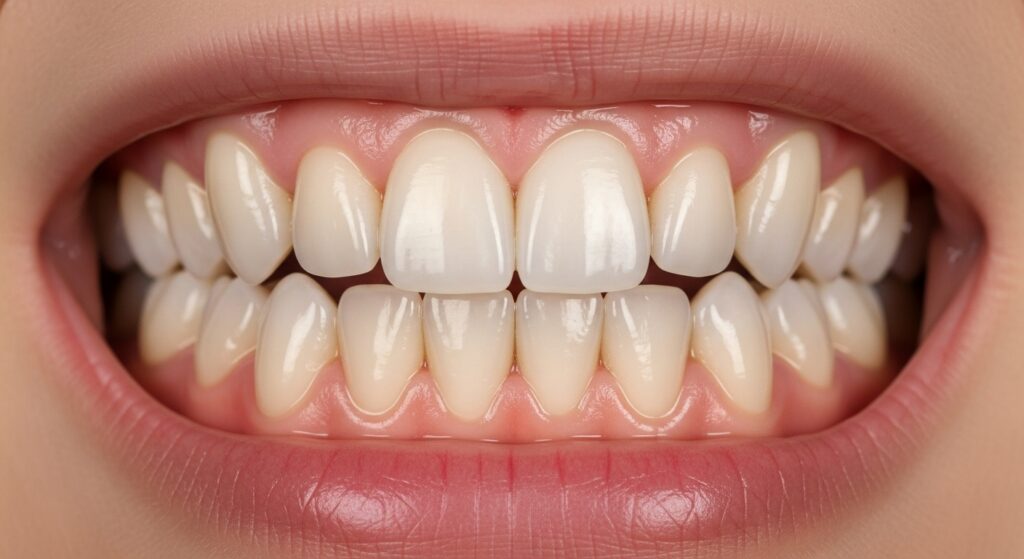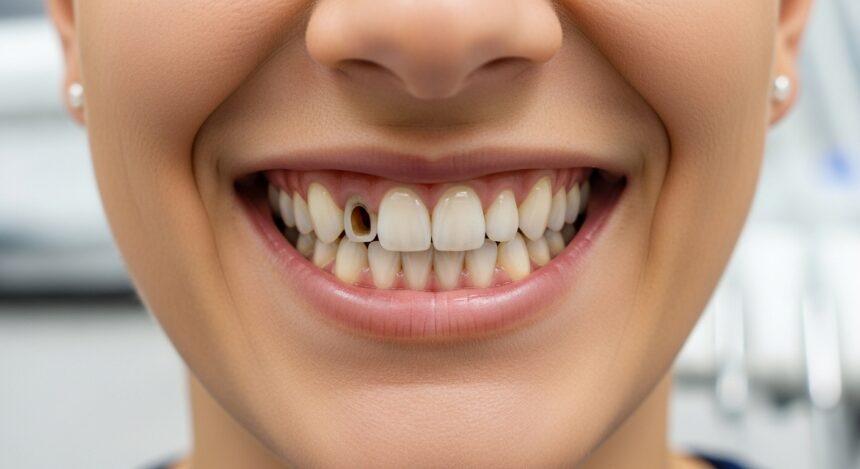Table of Contents
Dental veneers for missing teeth spark curiosity for those seeking a flawless smile. Many wonder if dental veneers can address gaps left by lost teeth. We explore their role, limitations, and the best alternatives to restore your smile confidently.
Missing teeth affect more than appearance; they impact oral health and confidence. Dental veneers enhance aesthetics but cannot replace missing teeth. We cover their purpose, alternatives like implants and bridges, and why a consultation is key to a radiant smile.
Dental Veneers and Their Purpose
Dental veneers transform smiles by covering imperfections. Invented in the 1930s by Dr. Charles Pincus for Hollywood stars, they earned the term “Hollywood smile.” Today, they remain a top choice for cosmetic dentistry.
Veneers are thin shells, typically porcelain, bonded to the front of teeth. They hide flaws like chips, cracks, discoloration, crookedness, or gaps. Their natural look and durability make them popular for aesthetic enhancements.
Types of Dental Veneers

Two main types of dental veneers exist: porcelain and composite. Each offers unique benefits and considerations. Here’s a breakdown:
| Type | Material | Durability | Application | Pros | Cons |
|---|---|---|---|---|---|
| Porcelain Veneers | High-quality ceramic | 10-15 years or more | Lab-crafted, 2-3 visits | Stain-resistant, natural look, durable | Higher cost, irreversible process |
| Composite Veneers | Tooth-colored resin | 5-7 years | Single visit, in-office | Lower cost, less invasive, repairable | Prone to staining, less durable |
Porcelain veneers reflect light like natural teeth and resist stains. Composite veneers are budget-friendly but may chip or stain. BellaVeneers, a unique snap-on option, use 0.5mm thick, BPA-free copolyester for a natural, stain-resistant finish.
How Veneers Are Applied
Applying dental veneers involves precise steps. Dentists start with a consultation to assess oral health. A small amount of enamel is removed to ensure a flush fit, as done at Yarema Dental with minimally invasive techniques.
Impressions or digital scans create custom veneers. Porcelain veneers are lab-crafted over weeks, while composite veneers are shaped in-office. The final step bonds veneers to teeth, ensuring a seamless, natural appearance.
Why Dental Veneers Cannot Replace Missing Teeth
Dental veneers for missing teeth are not a solution. Veneers require existing tooth structure for bonding. Without a tooth, they cannot function or restore chewing ability.
Missing teeth cause serious issues. Nearby teeth may shift, leading to crowding or misalignment. This increases gum disease risk, wears front teeth faster, and causes bone loss, potentially leading to further tooth loss.
Consequences of Not Replacing Missing Teeth
Ignoring missing teeth harms oral health. Here are key risks:
- Shifting Teeth: Adjacent teeth move into gaps, causing misalignment.
- Gum Disease: Exposed areas collect bacteria, increasing infection risk.
- Bone Loss: Lack of stimulation weakens the jawbone.
- Increased Wear: Front teeth bear extra load, wearing down faster.
Addressing missing teeth promptly preserves your smile and health. Alternatives like implants or bridges are essential for full restoration.
Best Alternatives for Missing Teeth

Since dental veneers for missing teeth aren’t viable, other options restore function and aesthetics. We explore dental implants, bridges, dentures, and combination treatments. Each suits different needs and budgets.
Dental Implants: A Permanent Solution
Dental implants are the gold standard for replacing missing teeth. A titanium post is surgically placed in the jawbone, acting as a tooth root. After months of integration, a crown tops the implant, mimicking a natural tooth.
Implants restore chewing, enhance appearance, and stimulate bone health. They can last a lifetime with care. However, they require surgery and time, making them pricier than other options.
Dental Bridges: Bridging the Gap
Dental bridges anchor artificial teeth to adjacent natural teeth or implants. They restore one or more missing teeth effectively. Bridges are quicker and less costly than implants, offering a fixed solution.
Bridges improve appearance and function but require healthy adjacent teeth. Maintenance is straightforward, but they may need replacement every 5-15 years. They’re ideal for those seeking a balance of cost and durability.
Removable Dentures: A Budget-Friendly Option
Removable dentures, full or partial, replace multiple missing teeth. They’re the least expensive option but less comfortable. Dentures restore appearance but may slip or require adhesive.
Dentures are suitable for those with multiple missing teeth or budget constraints. Regular cleaning and adjustments ensure fit. They don’t prevent bone loss like implants do.
Combination Treatment: Implants and Veneers
The most recommended approach combines dental implants with dental veneers. An implant replaces the missing tooth with a crown, while veneers enhance surrounding teeth. This creates a uniform, stunning smile.
This method addresses both function and aesthetics. It’s ideal for a complete smile makeover. Costs are higher, but the results are long-lasting and natural.
Closing Small Gaps with Veneers
For small gaps from missing teeth, dental veneers can sometimes help. Slightly wider veneers on adjacent teeth may close minor spaces. This works best for tiny teeth or natural gaps, not large missing areas.
This approach enhances aesthetics without replacing the tooth. It’s not a functional fix and requires healthy adjacent teeth. A dentist’s evaluation determines suitability.
BellaVeneers: A Unique Snap-On Solution
BellaVeneers offer a non-invasive alternative for cosmetic enhancement. These 0.5mm thick, BPA-free copolyester veneers snap over existing teeth. They use FDA-approved materials, matching local dentist quality.
Order online, receive an impression kit, and get custom veneers in weeks. They’re removable, painless, and budget-friendly compared to traditional veneers, which cost $900-$2,500 per tooth. Flexible financing with 0% interest makes them accessible.
Benefits of BellaVeneers
BellaVeneers stand out for their ease and quality. Key advantages include:
- Natural Look: Mimics tooth translucency for a seamless smile.
- Non-Invasive: No drilling or enamel removal required.
- Durability: Lasts 2-5 years with proper care.
- Convenience: Snap-on design allows easy removal.
Highly trained smile consultants support the process. Patented snap-in technology ensures confident speaking. They’re ideal for cosmetic fixes but not for replacing missing teeth.
Maintaining Dental Veneers for Longevity
Proper care extends the life of dental veneers. Porcelain veneers last 10-15 years or more with maintenance. Composite veneers last 5-7 years but are easier to repair.
Brush twice daily with a soft-bristled toothbrush and non-abrasive toothpaste. Floss daily to prevent plaque buildup. Avoid biting hard objects like ice or nails to prevent chips.
Bi-annual dental check-ups monitor veneer condition and oral health. A custom night guard protects against grinding. These steps keep your smile bright and durable.
Why a Dental Consultation Matters

A thorough consultation is crucial for dental veneers for missing teeth or alternatives. Skilled cosmetic dentists assess oral health, X-rays, and goals. New Jersey Porcelain Veneers offers a free $300 consultation.
Dentists tailor treatment plans to your needs. They evaluate if veneers, implants, or bridges suit you best. This ensures a functional, beautiful smile that boosts confidence.
Comparing Costs of Treatment Options
Costs vary for replacing missing teeth or enhancing smiles. Here’s a comparison:
| Treatment | Cost Range | Durability | Procedure Time |
|---|---|---|---|
| Dental Implants | $3,000-$5,000/tooth | Lifetime | Months |
| Dental Bridges | $1,500-$3,500 | 5-15 years | Weeks |
| Removable Dentures | $500-$3,500 | 5-7 years | Days to weeks |
| Porcelain Veneers | $900-$2,500/tooth | 10-15 years | Weeks |
| Composite Veneers | $250-$1,500/tooth | 5-7 years | Single visit |
| BellaVeneers | $500-$1,000/set | 2-5 years | Weeks |
Costs depend on location, dentist expertise, and oral health. Financing options, like BellaVeneers’ 0% interest plans, ease expenses. Consultations clarify budget-friendly choices.
Final Thoughts
Dental veneers for missing teeth don’t replace lost teeth but enhance existing ones. For gaps, implants, bridges, or dentures restore function, while veneers perfect aesthetics. Consult a skilled dentist to craft your ideal smile.
Combination treatments, like implants with dental veneers, offer comprehensive results. BellaVeneers provide a non-invasive cosmetic boost. With proper care, your smile can shine for years, boosting confidence and health.
FAQs
Can dental veneers replace a missing tooth?
No, dental veneers for missing teeth cannot replace them. They require existing teeth for bonding. Implants or bridges are better options.
How long do porcelain veneers last?
Porcelain dental veneers last 10-15 years or more with proper care. Regular brushing, flossing, and check-ups extend their lifespan.
Are BellaVeneers a good alternative to traditional veneers?
BellaVeneers are non-invasive and cost-effective for cosmetic fixes. They snap on and off but don’t replace missing teeth.
What happens if I don’t replace a missing tooth?
Missing teeth cause shifting, gum disease, bone loss, and faster wear. Replacing them with implants or bridges prevents these issues.
How do I know if I’m a candidate for dental veneers?
A dentist’s consultation assesses oral health and goals. Healthy teeth and gums are needed for dental veneers.








